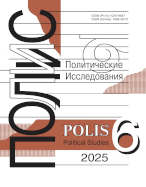“Quad 2.0”:
Quadrilateral Dialogue for Counterbalancing China in the Indo-Pacific
Khudaykulova A.V.,
Associate Professor, Department of Applied International Analysis, MGIMO University, Alexandra_77@mail.ru
elibrary_id: 252042 | ORCID: 0000-0003-0680-9321 | RESEARCHER_ID: E-5661-2017
Ramich M.S.,
postgraduate student, Department of Theory and History of International Relations, RUDN University, ramich_ms@mail.ru
elibrary_id: 1042878 |
DOI: 10.17976/jpps/2020.03.03
Khudaykulova A.V., Ramich M.S. “Quad 2.0”: Quadrilateral Dialogue for Counterbalancing China in the Indo-Pacific. – Polis. Political Studies. 2020. No. 3. https://doi.org/10.17976/jpps/2020.03.03
The reported study was funded by RFBR and EISR according to the research project No. 19-011-31389 “Traditional and emerging powers: discussions on sovereignty and conflict management”.
“Free and Open Indo-Pacific” (FOIP) is a US foreign policy concept. Its implementation started with President Trump’s administration coming to power and is being actively promoted now. The concept has a strong geostrategic orientation and relies on the largest regional powers of Japan, Australia and India, – the closest partners of Washington in the region. Despite the ongoing differences in setting the priorities of a new regional security structure, members of “Quad” are mostly concerned about China’s growing economic influence and potential military dominance, not only in the Asia-Pacific region, but also in the Indian Ocean. Therefore, the general basis of the Quadrilateral security dialogue in the Indo-Pacific region would be the deterrence of Chinese power and the maintenance of the regional balance of power. The IPR concept is currently at the institutionalization stage. At the same time, the stable trend for strengthening economic, military and political interaction between “Quad” members is continuously developing, regardless of their vision of the framework and the pace of its implementation. In such conditions, the issues of the development of the Indo-Pacific region and the prospects for the further formation of this “Security Diamond” will remain the highest agenda, especially as there are no clear prerequisites for easing U.S.-Chinese tensions. This article analyzes the formation of the IPR as a new geopolitical region, examines changes in doctrinal documents and the dynamics of bilateral relations among “Quad” members, and proposes a forecast for the design of a new regional security system.
References
Brummer Ch. 2014. Minilateralism. How Trade Alliances, Soft Law and Financial Engineering are Redefining Economic Statecraft. Cambridge: Cambridge University Press.
Buzan B., W.ver O. 2003. Regions and Powers: The Structure of International Society. Cambridge: Cambridge University Press.
Cha V.D. 1999. Alignment Despite Antagonism: The US–Korea–Japan Security Triangle. Stanford, CA: Stanford University Press.
Chacko P. 2014. The Rise of the Indo-Pacific: Understanding Ideational Change and Continuity in India’s Foreign Policy. – Australian Journal of International Affairs. Vol. 68. No. 4. P. 433-452. http://dx.doi.org/10.1080/10357718.2014.891565
Choong W. 2019. The Return of the Indo-Pacific Strategy: An Assessment. – Australian Journal of International Affairs. Vol. 73. No. 5. P. 415-430. https://doi.org/10.1080/10357718.2019.1639134
Clinton H. 2011. America’s Pacific Century. – Foreign Policy. 11.10. URL: https://foreignpolicy.com/2011/10/11/americas-pacific-century/ (accessed 25.03.2020).
Gopal P. 2017. Maritime Security in the Indo-Pacific: The Role of the US and its Allies. – Maritime Affairs: Journal of the National Maritime Foundation of India. Vol. 13. No. 1. P. 27-40. https://doi.org/10.1080/09733159.2017.1321208
Green M., Hicks K., Cooper Z. 2014. Federated Defense in Asia. Report. CSIS, December 2014.
Green M., Shearer A. 2012. Defining U.S. Indian Ocean Strategy. – The Washington Quarterly. Vol. 35. No. 2. P. 175-189. http://dx.doi.org/10.1080/0163660X.2012.666925
Hosoya Y. 2019. FOIP 2.0: The Evolution of Japan’s Free and Open Indo-Pacific Strategy. – Asia-Pacific Review. Vol. 26. No. 1. P. 18-28. https://doi.org/10.1080/13439006.2019.1622868
India and Japan. Assessing the Strategic Partnership. 2018. Ed. by R. Basrur, S.N. Kutty. Singapore: Palgrave Macmillan. https://doi.org/10.1007/978-981-10-8309-9
International Disaster Response. Rebuilding the Quad? 2019. Ed. by Tatsumi Y., Li J. Stimson Center. URL: https://www.stimson.org/wp-content/files/file-attachments/Quad-R4-WEB.pdf (accessed 20.04.2020).
Ishibashi N. 2017. Japan’s Policy Toward India Since 2000: For the Sake of Maintaining US Leadership in East Asia. – The Pacific Review. Published online. http://dx.doi.org/10.1080/09512748.2017.1396355
Ishihara Y. 2013. Japan-Australia Security Relations and the Rise of China: Pursuing the “Bilateral-Plus” Approaches. – UNISCI Discussion Papers. No. 32. P. 81-98. http://dx.doi.org/10.5209/rev_UNIS.2013.n32.4479
Kaplan R. 2010. Monsoon: The Indian Ocean and the Future of American Power. New York: Random House.
Khilnani S., Kumar R., Mehta P.B., Menon P., Nilekani N., Raghavan S., Saran Sh., Varadarajan S. 2012. NonAlignment 2.0. A Foreign and Strategic Policy for India in the 21 century. Center for Policy Research.
Khudaykulova A.V. 2019. China as an Emerging Actor in Conflict Management: From Non-Interference to “Constructive Engagement”. – Vestnik RUDN. International Relations. Vol. 19. No. 3. P. 580-602. https://doi.org/10.22363/2313-0660-2019-19-3-420-431
Khurana G.S. 2007. Security of Sea Lines: Prospects for India-Japan Cooperation. – Strategic Analysis. Vol. 31. No. 1. P. 139-153. https://doi.org/10.1080/09700160701355485
Kitaoka Sh. 2019. Vision for a Free and Open Indo-Pacific. – Asia-Pacific Review. Vol. 26. No. 1. P. 7-17. https://doi.org/10.1080/13439006.2019.1618592
Korybko A. 2018. The Competition Between China and India in East Africa As Expressed Through the Rival Silk Road and Asia-Africa Growth Corridor Projects. – The Turn of Africa to the East and Russia’s interests. Moscow: Institute of African Studies. P. 97-112.
Medcalf R. 2014. In Defence of the Indo-Pacific: Australia’s New Strategic Map. – Australian Journal of International Affairs. Vol. 68. No. 4. P. 470-483. http://dx.doi.org/10.1080/10357718.2014.911814
Pant H.V., Rej A. 2018. Is India Ready for the Indo-Pacific? – The Washington Quarterly. Vol. 41. No. 2. P. 47-61. https://doi.org/10.1080/0163660X.2018.1485403
Patrick S. 2014. The Unruled World. The Case for Good Enough Global Governance. – Foreign Affairs. Vol. 93. No. 1. P. 58-73.
Rai A. 2018. Quadrilateral Security Dialogue 2 (Quad 2.0) – a Credible Strategic Construct or Mere “Foam in the Ocean”? – Maritime Affairs: Journal of the National Maritime Foundation of India. Vol. 14. No. 2. P. 138-148. https://doi.org/10.1080/09733159.2019.1572260
Roy-Chaudhury R., de Estrada K.S. 2018. India, the Indo-Pacific and the Quad. – Survival. Vol. 60. No. 3. P. 181-194. https://doi.org/10.1080/00396338.2018.1470773
Satake T., Hemmings J. 2018. Japan–Australia Security Cooperation in the Bilateral and Multilateral Contexts. – International Affairs. Vol. 94. No. 4. P. 815-834. https://doi.org/10.1093/ia/iiy028
Security Communities. 1998. Ed. by E. Adler, M. Barnett. Cambridge: Cambridge University Press. https://doi.org/10.1017/CBO9780511598661
Scott D. 2012. The “Indo-Pacific” – New Regional Formulations and New Maritime Frameworks for US-India Strategic Convergence. – Asia-Pacific Review. Vol. 19. No. 2. P. 85-109. http://dx.doi.org/10.1080/13439006.2012.738115
Thakur R., Sharma A. 2018. India in Australia’s Strategic Framing in the Indo–Pacific. – Strategic Analysis. Vol. 42. No. 2. P. 69-83. https://doi.org/10.1080/09700161.2018.1439328
Thankachan Sh. 2017. Japan’s “Free and Open Indo-Pacific Strategy”: Reality before the Rhetoric? – Maritime Affairs: Journal of the National Maritime Foundation of India. Vol. 13. No. 2. P. 84-91. https://doi.org/10.1080/09733159.2017.1414831
Tyler M.H.C., Bhutoria A. 2015. Diverging Australian and Indian Views on the Indo-Pacific. – Strategic Analysis. Vol. 39. No. 3. P. 225-236. http://dx.doi.org/10.1080/09700161.2015.1022314
Walt S. 1987. The Origins of Alliances. London: Cornell University Press.
Waltz K. 1979. Theory of International Politics. Boston: McGraw-Hill.
Bogaturov A.D. 1997. Velikie derzhavy na Tikhom okeane. Istoriya i teoriya mezhdunarodnykh otnoshenii v Vostochnoi Azii posle Vtoroi mirovoi voiny (1945-1995) [Great Powers in the Pacific. The History and Theory of International Relations in East Asia After the Second World War (1945-1995)]. Moscow: Konvert-MONF. (In Russ.)
Chugrov S.V. 2008. Japan: Hybridization and Harmonization. – Polis. Political Studies. No. 3. P. 59-67. (In Russ.) URL: https://www.politstudies.ru/article/3987 (accessed 04.02.2020).
Istomin I.A. 2017. Western Theory of International Military Alliances. The State of the Discipline. – International Trends. Vol. 15. No. 4. P. 93-114. (In Russ.) https://doi.org/10.17994/IT.2017.15.4.51.6
Istomin I.A. 2019. Politika SShA v Indo-Tikhookeanskom Regione: Posledstviya Dlya Rossii. Rabochaya Tetrad’ RSMD № 49 [US Policy in the Indo-Pacific Region: Implications for Russia. RIAC Workbook No. 49]. Moscow: NP RIAC. 44 p. (In Russ.)
Kanaev E.A., Shumkova V.A. 2017. ASEAN-led Multilateral Security Dialogue: Eurasian
Priorities. – Vestnik RUDN. International Relations. Vol. 17. No. 3. P. 458-468. (In Russ.) https://doi.org/10.22363/2313-0660-2017-17-3-458-468
Kaplan R.D. Indian Ocean and the Future of American Power. (Russ. ed.: Kaplan R.D. Musson: Indiiskii okean i budushchee amerikanskoi politiki. Moscow: KoLibri, Azbuka-Atikus).
Karimova A.B. 2019. Connecting the Indian and the Pacific, or Influence Tools Modernization. – World Economy and International Relations. Vol. 63. No. 6. P. 13-24. (In Russ.). https://doi.org/10.20542/0131-2227-2019-63-6-13-24
Kistanov V.O. 2018. Japan’s Anti-China Strategy in the Indo-Pacific Region. – Actual Problems of Modern Japan. No. 32. P. 31-44. (In Russ.)
Kupriyanov A.V. 2018. IBSAMAR: India’s Imperatives, Transformation Prospects. – Vestnik RUDN. International Relations. Vol. 18. No. 3. P. 628-641. (In Russ.) https://doi.org/10.22363/2313-0660-2018-18-3-628-641
Kupriyanov A.V. 2019. Geopolitics of the Sea: the Idea of Ocean Control in the Political Discourse of Independent India. – Vestnik RUDN. International Relations. Vol. 19. No. 2. P. 234-246. (In Russ.) https://doi.org/10.22363/2313-0660-2019-19-2-234-246
Lebedeva N.B. 2018. Indiiskii okean: vyzovy XXI v. i Indiya. Ocherki mezhdunarodnykh otnoshenii [Indian Ocean: Challenges of the 21st Century and India. Essays on International Relations]. Moscow: IV RAN. (In Russ.)
Leksyutina Y.V. 2019. China in D. Trump’s Free and Open Indo-Pacific Strategy. – Vestnik RUDN. International Relations. Vol. 19. No. 1. P. 22-34. (In Russ.) https://doi.org/10.22363/2313-0660-2019-19-1-22-34
Lokshin G.M. 2018. Trump’’s Doctrine as a Course to Create a New Bloc in Asia. – Problemy Dal’nego Vostoka. No. 3. P. 4-16. (In Russ.)
Panov A.N., Nelidov V.V. 2018. Japan’s Foreign Policy in the Context of Military-Political Situation in North East Asia. – Japanese Studies in Russia. No. 4. P. 78-91. (In Russ.) https://doi.org/10.24411/2500-2872-2018-10029
Patrick S. 2015. Vybor a la carte: novyi mir global’nogo upravleniya. Valdaiskie zapiski № 22 [A La Carte Choice: A New World of Global Governance. Valdai Notes No. 22.]. (In Russ.) URL: https://ru.valdaiclub.com/a/valdai-papers/valdayskaya-zapiska-22/ (accessed 04.02.2020).
Reformatting the System of International Relations in Pacific Asia: Vectors and Dynamics of Changes (Part I). 2018. – World Economy and International Relations. Vol. 62. No. 12. P. 100-108. (In Russ.) https://doi.org/10.20542/0131-2227-2018-62-12-100-108
Reformatting the System of International Relations in Pacific Asia: Vectors and Dynamics of Changes (Part II). 2019. – World Economy and International Relations. Vol. 63. No. 1. P. 112-122. (In Russ.) https://doi.org/10.20542/0131-2227-2019-63-1-112-122
Strel’tsov D.V. 2018. Indo-Pacific Region as a New Reality of the Global System of International Relations. – The International Affairs. No. 9. P. 65-74. (In Russ.)
See also:
Kupriyanov A.V.,
Russia and India: problems and prospects for cooperation. – Polis. Political Studies. 2022. No4
Dobransky S.,
The formation of a Black sea community. – Polis. Political Studies. 2013. No1
Nikitin A.I.,
The global power of the future: renewal of strategic orientations of India. – Polis. Political Studies. 2025. No1
Arbatova N.K.,
Climate threats – a new dimension of EU security. – Polis. Political Studies. 2022. No6
Arbatov A.G.,
China and Arms Control: Not Utopia, but a Reality. – Polis. Political Studies. 2020. No4




.jpg)






 print
print
.jpg)
.jpg)